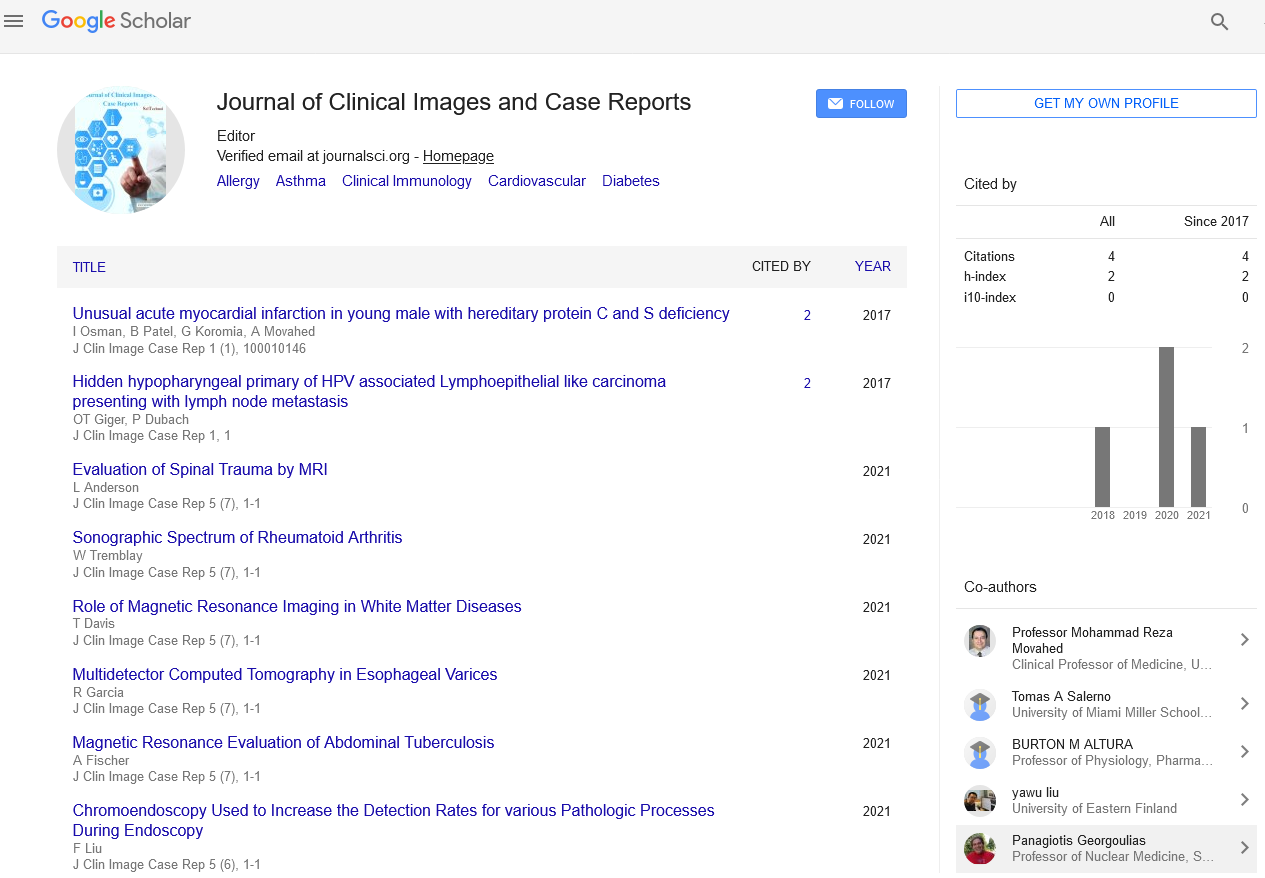Opinion Article, J Clin Image Case Rep Vol: 7 Issue: 1
The Symptoms and Responses of Allergie in Immune System
Cheryl Hage*
Department of Medicine, Karolinska University Hospital, Stockholm, Sweden
*Corresponding Author: Cheryl Hage
Department of Medicine, Karolinska
University Hospital, Stockholm, Sweden
E-mail: hagecheryl@gmail.com
Received date: 27 January, 2023, Manuscript No. CICR-23-95477;
Editor assigned date: 30 January, 2023, PreQC No. CICR-23-95477(PQ);
Reviewed date: 14 February, 2023, QCNo CICR-23-95477;
Revised date: 21 February 2023, Manuscript No. CICR-23-95477(R);
Published date: 28 February 2023 DOI: 10.4172/CICR.100023 .
Citation: Hage C (2023) The Symptoms and Responses of Allergie in Immune System. J Clin Image Case Rep 7:1.
Description
Allergy is a common condition that affects millions of people worldwide. It occurs when the immune system overreacts to harmless substances, known as allergens, resulting in a wide range of symptoms, ranging from mild to severe. Allergies can affect various organs and tissues in the body, such as the skin, respiratory tract, digestive tract, and eyes. In this article, we will delve into the complexities of allergies, including their types, causes, symptoms, diagnosis, treatment, and prevention.
Types of allergies
Respiratory allergies: These are the most common types of allergies and include allergic rhinitis (hay fever) and asthma. Allergic rhinitis is characterized by symptoms such as sneezing, runny nose, congestion, and itching of the eyes, nose, and throat.
Skin allergies: These allergies affect the skin and include conditions such as atopic dermatitis (eczema), contact dermatitis, and urticaria (hives). Atopic dermatitis is a chronic skin condition characterized by dry, itchy, and inflamed skin.
Food allergies: These allergies occur when the immune system reacts to certain proteins in food, leading to symptoms such as hives, swelling, itching, abdominal pain, nausea, vomiting, diarrhea, and in severe cases, anaphylaxis, a life-threatening allergic reaction.
Causes of allergies
Allergies are caused by the immune system's overreaction to normally harmless substances, known as allergens. When the immune system encounters an allergen, it mistakenly identifies it as a threat and produces antibodies, such as Immunoglobulin E (IgE), to attack it.
This immune response triggers the release of various chemicals, such as histamine, which leads to inflammation and the characteristic allergy symptoms.
The exact causes of allergies are complex and multifactorial, involving a combination of genetic, environmental, and lifestyle factors. Family history of allergies increases the risk of developing allergies, as there is a genetic predisposition to allergic reactions. Environmental factors, such as exposure to allergens, pollution, and changes in climate, can also influence the development of allergies. Lifestyle factors, such as diet, hygiene practices, and exposure to pets, may also play a role in the development of allergies.
Symptoms of allergies
The symptoms of allergies can vary depending on the type and severity of the allergy. Common symptoms of allergies include:
• Sneezing, runny nose, congestion, itching of the eyes, nose, and throat, coughing, wheezing, chest tightness, and shortness of breath.
• Dry, itchy, and inflamed skin, redness, rash, swelling, blisters, oozing, and crusting.
• Hives, swelling of the lips, tongue, or face, itching or tingling in the mouth, abdominal pain, nausea, vomiting, diarrhea, and in severe cases, difficulty breathing, chest tightness, and anaphylaxis.
• Swelling, redness, itching, pain, and warmth at the site of the bite or sting, hives, difficulty breathing, chest tightness, and in severe cases, anaphylaxis.
Treatment of allergies
The management of allergies typically involves avoiding triggers, relieving symptoms, and in some cases, desensitization or immunotherapy. The treatment plan depends on the type and severity of the allergy and may include:
Avoidance of triggers: Identifying and avoiding allergens that trigger allergies is the first line of defense. This may involve making changes in the environment, such as using air purifiers, keeping windows closed, and avoiding outdoor activities during peak pollen seasons. It may also involve avoiding specific foods, insect bites, or stings, and using hypoallergenic products for the skin.
Immunotherapy: Immunotherapy, also known as allergy shots or Sublingual Immunotherapy (SLIT), involves gradually exposing the patient to increasing doses of the allergen to desensitize the immune system and reduce the severity of allergic reactions. Immunotherapy is typically used for respiratory allergies, such as allergic rhinitis and asthma, and may be recommended when symptoms are not wellcontrolled with medications or when the allergens cannot be avoided.
 Spanish
Spanish  Chinese
Chinese  Russian
Russian  German
German  French
French  Japanese
Japanese  Portuguese
Portuguese  Hindi
Hindi 